What’s Belizean Food Without Coconut Oil?
Coconut oil, it’s been a Belizean kitchen staple for generations, adding that rich, unforgettable flavor to rice and beans, stewed meats, and so many of our favorite dishes. But have you ever wondered how it’s made? Tonight, on Kolcha Tuesday, we’re taking you to Biscayne Village, where the Rasta Family Pot restaurant is serving up farm-to-table goodness. Husband-and-wife duo Francine and Darwin August are not only cooking up mouthwatering meals, they’re infusing them with their very own homemade coconut oil. News Five’s Britney Gordon takes us behind the scenes to show how this traditional ingredient is made and why it remains such an essential part of Belizean culture.

Francine August
Francine August, Co-owner, Rasta Family Pot
“It’s flavorful. You could taste the richness of the coconut. The rice is shiny, the beans is creaming. Food isn’t food without coconut oil.”
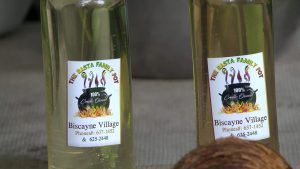 Britney Gordon, Reporting
Britney Gordon, Reporting
If you peek into almost any Belizean kitchen, chances are you’ll spot a bottle of coconut oil on the shelf. It’s in our skincare, our hair care, and of course, in our food. For many, it’s the secret ingredient that gives Belizean dishes that unmistakable tropical flavor. But in Biscayne Village, at the Rasta Family Pot restaurant, co-owner Francine August takes it a step further. She makes her own coconut oil, straight from coconuts grown on her farm. It’s farm-to-table at its finest, and tonight we’ll show you how this traditional staple is manufactured and why it remains such a beloved part of our culture.
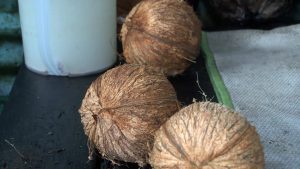 Francine August
Francine August
“I have a lot of coconuts on my farm, and like I say, we use the stuff off our farm and I am the type of person that I’m willing to learn any and everything and as I was growing up, my mother used coconut tar ’cause food without coconut oil is no food at all, right? So we fry our beans with coconut oil, cook the rice and beans with coconut oi, everything. Grilled the chicken, stir the chicken with coconut oil. So since I have a lot of coconuts. So, then I make my coconut oil and use my coconuts.”
 Francine and her husband, Darwin August, have been running the restaurant for about seven years and it all began with a shared appreciation for food. Together, they create a menu rooted in authentic Belizean flavors, with their homemade coconut oil at its heart.
Francine and her husband, Darwin August, have been running the restaurant for about seven years and it all began with a shared appreciation for food. Together, they create a menu rooted in authentic Belizean flavors, with their homemade coconut oil at its heart.
Francine August
“We have the coconut in the husk. My husband take it out the husk. Chop it open. We grind it, we squeeze it, and then we have to leave it overnight. And then this is a separation. This is the water and this is the cream from the coconut. And we take this off and we fry it and let it cool and we bottle it.”
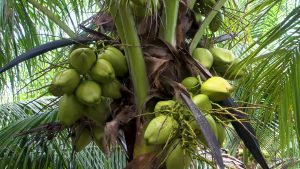 A quality bottle of coconut oil starts with the plant itself and choosing the right fruit. Darwin August explains that he takes his time choosing the right one for the best bottle.
A quality bottle of coconut oil starts with the plant itself and choosing the right fruit. Darwin August explains that he takes his time choosing the right one for the best bottle.
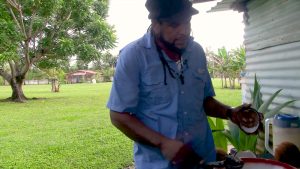
Darwin August
Darwin August, Co-owner, Rasta Family Pot
“So the first thing with coconut oil is selecting the right coconut to plant for your coconut oil. I prefer the big nut. Because you use less when you’re making a coconut, and these are fatty coconut as well compared to some of the smaller ones which have less fat in it. A lot of people in their grating too, they don’t like the burning, the coconut itself, but from me doing it for so long, you’ll notice that there’s a lot of oil in the burn itself. So I try to get out a bit of the burn. Not too much of have shell in it, but just enough that I get out most of the oil, all of the coconut.”
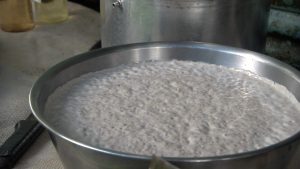 After coconuts are grated and squeezed, the milk is left to sit overnight. Some choose to leave it for a couple days, depending on their preference. This is done so that the fats separate in the milk before frying.
After coconuts are grated and squeezed, the milk is left to sit overnight. Some choose to leave it for a couple days, depending on their preference. This is done so that the fats separate in the milk before frying.
 Darwin August
Darwin August
“It takes about between ten to twelve coconuts to get a seven hundred and twenty milliliter bottle of coconut oil. Very, very labor intensive and this is the process of grading it. The Mennonite have mechanized this process right here, guys. This is the part that really kills hand, so they have now. Hook this up to a motor that you can just put it here and it grates it for you.”
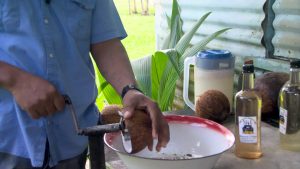 The oil is then fried for up to four hours until brown sediments start to separate from the bottom. For the couple, this entire process takes about twelve hours but they believe it is worth it to have quality ingredients fresh for their customers.
The oil is then fried for up to four hours until brown sediments start to separate from the bottom. For the couple, this entire process takes about twelve hours but they believe it is worth it to have quality ingredients fresh for their customers.
Francine August
“Everybody loves Rasta product because I was raised, anything doing is worth doing right. Or not or don’t do it any at all.”
Among all their offerings, coconut oil continues to be the top favorite with customers. Beyond its use in local cuisine, thousands of Belizeans across the country depend on the production of coconut oil for their income. It’s a tradition and a livelihood, one that’s been cemented as a cornerstone of Belize’s economy and everyday life. Britney Gordon for News Five.






Facebook Comments